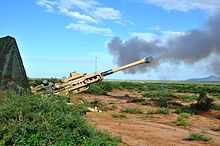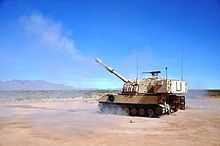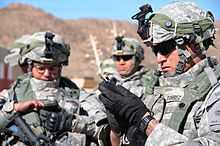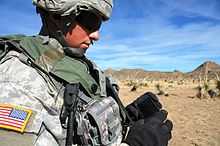Brigade Modernization Command

The Brigade Modernization Command (BMC) is the new name for the Future Force Integration Directorate (FFID), under The U.S. Army's Training and Doctrine Command (TRADOC) and the Army Capabilities Integration Center (ARCIC). The change reflects the Army’s commitment to its Incremental Brigade Modernization strategy and its effort to make BMC and the 2nd Brigade, 1st Armored Division the centerpiece of integrated network evaluations at Fort Bliss and White Sands Missile Range.
BMC conducts the integration and evaluations of the Army's network, capability packages and other capabilities to provide Doctrine, Organization, Training, Materiel, Leadership and Education, Personnel and Facilities recommendations to the Army. BMC gets capability solutions into the hands of soldiers faster than traditional channels by utilizing support from combat, training, and material developers and engineers early on in the development lifecycle.
History


The Brigade Modernization Command was initially founded as the Future Force Integration Directorate at Fort Bliss, Texas, based on an Army Chief of Staff directive to Training and Doctrine Command, dated December 20, 2005 to establish an on-site integration organization to facilitate development, testing and evaluation of the Future Combat Systems. FFID was organized as a directorate of the Army Capabilities Integration Center, a subordinate unit of TRADOC.
The organization's initial mission was to synchronize delivery, preparation and evaluation of all FCS-related products, which included complementary systems; development of doctrine, organization and training and leadership products which were synchronized with the FCS program manager, materiel developments and to exercise direct authority over the Army Evaluation Task Force, a unit of Soldiers that would test and evaluate the equipment.
The first FFID operations began at Fort Bliss on June 15, 2006. In December 2006, FFID was officially designated to exercise direct authority over the AETF. The AETF was officially activated on December 16, 2006 as the 5th Brigade Combat Team, 1st Armored Division, AETF.
In March 2007, ARCIC approved additional personnel for a general officer staff organization, which replicated a division headquarters. Brig. Gen. James L. Terry, FFID's first director, was welcomed in a formal ceremony on April 6, 2007. The establishment phase was scheduled to continue through June 2007.
In August 2007, the FFID mission was modified to integrate modernization efforts in support of Army transformation in order to provide FCS-enabled modular brigades beginning Fiscal Year 2011 and an FCS Brigade Combat Team at full operational capability in 2017 to joint force commanders. On October 1, 2007, FFID attained initial operational capability and assumed responsibility of FCS from the Unit of Action Maneuver Battle Laboratory based at Fort Knox, Ky.
During its short history, the organization conducted numerous training and testing events, as well as demonstrations of FCS capabilities for visits by senior Department of Defense and Army leadership, congressional leaders and staffers, business executives and national and local news media representatives. Distinguished visitors included the Secretary of Defense, Chief of Staff of the Army, Chairman of the House Armed Services Committee and other notable politicians and congressional staff delegations.
In April 2009, after the Secretary of Defense terminated the FCS program, FFID assumed responsibility for integrating BCT modernization for the Army. This included accelerated delivery of promising capabilities to the operating force. These "Spin Out" systems were bundled into "capability packages", which would be evaluated and delivered incrementally in two year periods.
In late 2010, the Army Vice Chief of Staff directed that FFID, along with Fort Bliss and White Sands Missile Range, become the Army's center for network integration. Since this would require a full Brigade Combat Team to load and test the network the Chief of Staff of the Army directed that the 2nd Brigade, 1st Armored Division take over the AETF mission from the 5th Brigade which would be deactivated in March 2011.
On February 7, 2011, the CSA directed that FFID be re-designated the Brigade Modernization Command with a mission to conduct physical integration and evaluations of the Army's network, capability packages and other capabilities in order to provide doctrine, organization, training, materiel, leadership, education, personnel and facility recommendations to the Army.
Today, BMC is focused on integrating test and evaluation events, including the Integrated Network Baseline Evaluation. The 2/1 AD conducts training and certification events to ensure individual and unit-level proficiency. While the network is central to Army brigade modernization efforts, 2/1 AD soldiers provide critical feedback that allows the U.S. Army to make decisions on which capabilities to acquire.
Network Integration Evaluation

The Network Integration Evaluation is a series of semi-annual evaluations designed to establish a Network Baseline and then rapidly build and mature the Army’s tactical Network.
During the Network Integration Evaluation scheduled for June 6, 2011 through July 15, 2011 at White Sands Missile Range, BMC, ATEC, and PEO-I will assess network and non-network capabilities, including Theater Provided Equipment, and developing and emerging network capabilities, and determine the implications of these capabilities across DOTMLPF. Success will be based on what can be learned when the capabilities are put in the hands of Soldiers in the field.
The Network Integration Evaluation will provide a means to evaluate relevant capabilities in parallel and make incremental improvements based upon a disciplined and professional feedback cycle. The effort will facilitate rapid evaluation of commercial and government network solutions to establish a Network Baseline and then rapidly build from it.
In addition to programs of record under test this June and July, a number of developing and emerging capabilities will be evaluated. The NIE events will help the Army achieve an agile process to optimize the BCT network. The 2012 Integrated Network Test will be the capstone event that solidifies the 2013-2014 Network Capability Set.
2nd Brigade, 1st Armored Division

In 2010, the U.S. Army attached 2nd Brigade, 1st Armored Division to the BMC, assigning it the evaluation mission previously held by the 5th Brigade, 1st Armored Division, AETF. The 2/1 AD has been given the mission of validating the operational relevancy of solutions and developing doctrine prior to fielding to deploying forces. It is an HBCT tasked organized that is equipped to replicate heavy, light and Stryker formations. 2/1 AD evaluates all network capability solution candidates and other Army Modernization capability candidates in a full spectrum operational environment at Fort Bliss, Texas and White Sands Missile Range. This unique Army mission supports adaptive evaluation of capability candidates, unit organizational design and operational concepts. The brigade provides immediate feedback that permits TRADOC to assess modernization concepts, identify implications, and enables the Army Test and Evaluation Command to assess the technical performance of materiel technologies.
2/1 AD Structure
- HHC 2nd BCT, 1st Armored Division
- 1st Battalion, 6th Infantry Regiment
- 1st Battalion, 35th Armor Regiment
- 1st Squadron, 1st Cavalry Regiment
- 4th Battalion, 27th Field Artillery Regiment
- 2nd Brigade Special Troops Battalion
- 47th Brigade Support Battalion
- Focus On: NIE on Army Brigade Combat Team Modernization website
References
- Brigade Modernization Command webpage, U.S. Army
- ARCIC Brigade Modernization Command webpage, U.S. Army
- Brigade Combat Team Modernization webpage, U.S. Army
External links
- Brigade Modernization Command webpage
- ARCIC Brigade Modernization Command webpage
- Brigade Combat Team Modernization webpage
- Brigade Modernization Command Facebook page
- Network Integration Evaluation Facebook page
